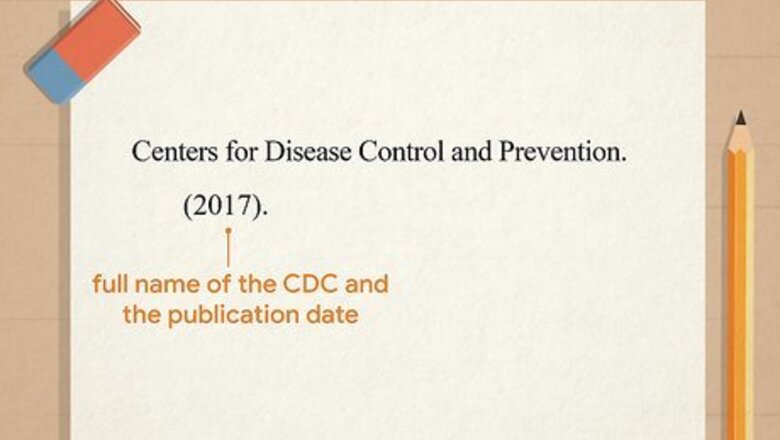
views
Creating a Citation for Your Reference List

List the full name of the CDC and the publication date first. The very first item in your Reference page citation entry should be the full name of the Centers for Disease Control and Prevention followed by a period. Then include the year of publication in parentheses, also followed by a period. For example: Centers for Disease Control and Prevention. (2017). If you are citing more than one document from the CDC published in the same year, distinguish them by putting a letter after the year. For instance, you could have "Centers for Disease Control and Prevention. (2017a)." and "Centers for Disease Control and Prevention. (2017b)."
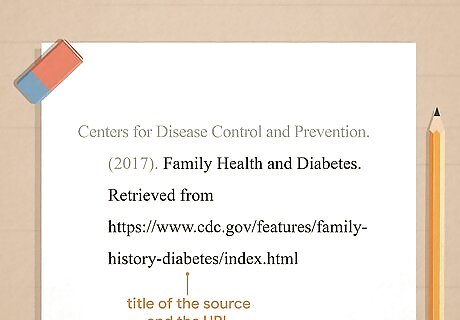
Provide the title of the source and the URL. After the name of the CDC and the publication date, you should list the full name of the CDC website page that you are quoting from, followed by a period. You should use italics when listing the title of a longer work – like the name of a book, journal, or PDF document. When listing website pages or other web-based documents, you should use sentence case capitalization. This means that most words (all except the first word and words that appear after colons or semicolons) are not capitalized. Then you should include the URL of the page preceded by the words “Retrieved from.” Centers for Disease Control and Prevention. (2017). Family health and diabetes. Retrieved from https://www.cdc.gov/genomics/famhistory/famhist_diabetes.htm There should not be a period at the end of the citation after the URL.
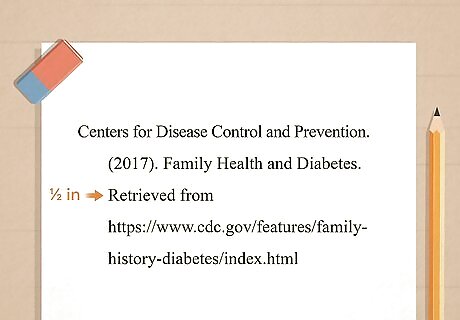
Use a hanging indentation for each line after the first. For each citation, the first line should be flush-left, with each subsequent line indented ⁄2 in (1.3 cm). This is called a hanging indentation. For example: Centers for Disease Control and Prevention. (2017). Family Health and Diabetes. Retrieved from https://www.cdc.gov/genomics/famhistory/famhist_diabetes.htm

Alphabetize the entry among your other sources. For a Reference page in APA format, all entries should be listed in alphabetical order. Alphabetize according to the first letter of the first word of the entry, excluding “a,” “an,” or “the.” In this case, your CDC citation will probably be situated toward the beginning of your References list because C is an early letter in the alphabet. Any reference beginning with letters D or later will appear after your CDC citation.
Creating the First In-Text Citation
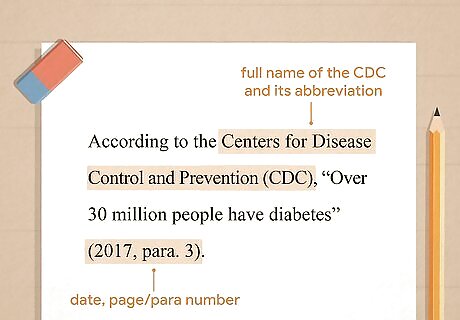
Include the full name of the CDC and its abbreviation in the sentence introducing the quotation. For the first citation, if you use the full name of the Centers for Disease and Control Prevention in the signal phrase preceding the quotation, you can follow it immediately with the abbreviation in parentheses. Then, for each subsequent citation, you can simply use the abbreviation. In this case, you’ll only include the date and the page number in the in-text citation. In the absence of a page number (in the case of web articles, for instance), you can list the paragraph number (“para.”) followed by the paragraph number. For example: According to the Centers for Disease Control and Prevention (CDC), “Over 30 million people have diabetes” (2017, para. 3).

Write the full name of the CDC and its abbreviation in parentheses. If you don’t include the full name of the Centers for Disease Control and Prevention in the introduction to the quote, you should include it, along with the abbreviated version (in brackets) in the parenthetical citation. For example: Certain studies have shown that “Over 30 million people have diabetes” (Centers for Disease Control and Prevention [CDC], 2017, para. 3).

Include the year of publication for the quoted material. In APA format, you always need to include the year of publication for the cited information. APA format is often used by scientists and other researchers who value using the most recent, up-to-date research, so including the date of publication is vital. For example: According to the Centers for Disease Control and Prevention, “Over 30 million people have diabetes” (CDC, 2017, para. 3). You should include the publication year in an in-text citation even after paraphrased material, not just direct quotes. Be sure to differentiate documents published in the same year by adding a letter after the year. For example, your in-text citations could read "(CDC, 2017a)" and "(CDC, 2017b)."
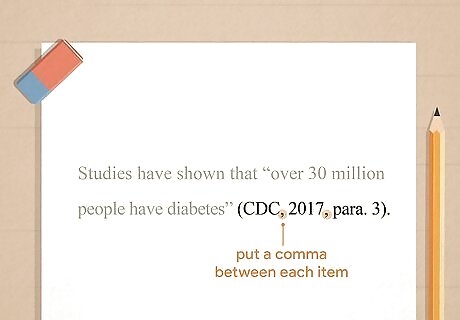
Put a comma between each item in the in-text citation. In APA format, you should include a comma to separate the name of the CDC and the publication date, and another comma between the date and the page or paragraph number. This helps separate the information in a clear way that avoids confusion. For example: (CDC, 2017, para. 3).
Generating Subsequent In-Text Citations
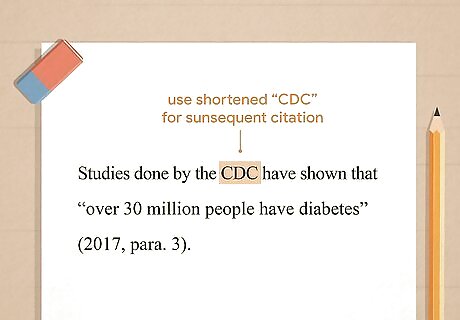
Use the abbreviated name for the CDC in the introduction to the quote. In APA format, you only need to write out the full name of the Centers for Disease Control and Prevention for the very first time you mention it. Every time after that, you can use the shortened “CDC” to refer to the organization. In this case, you only need to include the date of publication in the parenthetical citation and the page or paragraph number the quote can be found on. For example: Studies done by the CDC have shown that “over 30 million people have diabetes” (2017, para. 3).

Include the CDC abbreviation in the in-text citation. If you don’t name the CDC as the source in your introduction to the quote, you need to include the abbreviated version in the parenthetical citation. For example: Studies have shown that “over 30 million people have diabetes” (CDC, 2017, para. 3).

Include the year of publication and page/paragraph number in the parenthetical citation. In APA format, you should always include the year of publication for every instance of quoted material, not just the first one. List the publication year after the abbreviated name of the CDC, separated by a comma. Then include the page number or paragraph number the quoted portion can be found on. For example: According to the CDC, “over 30 million people have diabetes” (CDC, 2017, para. 3).




















Comments
0 comment